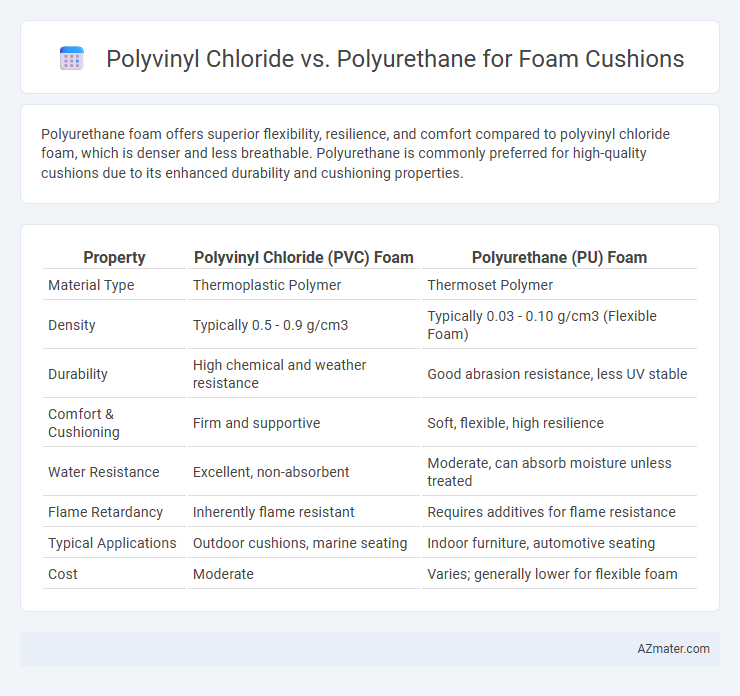Polyurethane foam offers superior flexibility, resilience, and comfort compared to polyvinyl chloride foam, which is denser and less breathable. Polyurethane is commonly preferred for high-quality cushions due to its enhanced durability and cushioning properties.
Table of Comparison
| Property | Polyvinyl Chloride (PVC) Foam | Polyurethane (PU) Foam |
|---|---|---|
| Material Type | Thermoplastic Polymer | Thermoset Polymer |
| Density | Typically 0.5 - 0.9 g/cm3 | Typically 0.03 - 0.10 g/cm3 (Flexible Foam) |
| Durability | High chemical and weather resistance | Good abrasion resistance, less UV stable |
| Comfort & Cushioning | Firm and supportive | Soft, flexible, high resilience |
| Water Resistance | Excellent, non-absorbent | Moderate, can absorb moisture unless treated |
| Flame Retardancy | Inherently flame resistant | Requires additives for flame resistance |
| Typical Applications | Outdoor cushions, marine seating | Indoor furniture, automotive seating |
| Cost | Moderate | Varies; generally lower for flexible foam |
Introduction to Foam Cushions: Materials Matter
Foam cushions rely heavily on material selection to determine comfort, durability, and application suitability. Polyvinyl chloride (PVC) offers excellent water resistance and chemical stability, making it ideal for outdoor and marine cushioning, while polyurethane (PU) provides superior flexibility and softness, commonly used for indoor furniture and automotive seating. Understanding the distinct properties of PVC and PU foams is essential for optimizing performance in foam cushion manufacturing and application.
What is Polyvinyl Chloride (PVC) Foam?
Polyvinyl Chloride (PVC) foam is a lightweight, closed-cell material known for its durability, chemical resistance, and flexibility, making it an ideal choice for foam cushions in various applications. PVC foam offers excellent resistance to moisture, oils, and abrasion, providing long-lasting comfort and support in furniture, automotive seating, and marine cushions. Its dense structure and flame-retardant properties distinguish it from polyurethane foam, which is typically softer and more breathable but less resistant to environmental factors.
What is Polyurethane (PU) Foam?
Polyurethane (PU) foam is a versatile synthetic material produced through the reaction of isocyanates and polyols, forming a flexible, lightweight, and durable cellular structure ideal for foam cushions. Compared to Polyvinyl Chloride (PVC) foam, PU foam offers superior elasticity, enhanced breathability, and better shock absorption, making it a preferred choice for comfort applications in furniture and automotive seating. The open-cell structure of PU foam allows for excellent air circulation and moisture resistance, contributing to its long-lasting performance in cushion manufacturing.
Key Differences Between PVC and PU Foam
Polyvinyl chloride (PVC) foam is a closed-cell material known for its durability, water resistance, and rigidity, making it ideal for outdoor and marine applications. Polyurethane (PU) foam is an open-cell or semi-rigid foam prized for its superior cushioning, flexibility, and breathability, often used in furniture and automotive seating. Key differences include PVC foam's higher resistance to chemicals and moisture versus PU foam's enhanced comfort and shock absorption capabilities.
Comfort and Support: PVC vs PU Foam Cushioning
Polyurethane (PU) foam cushions offer superior comfort and support due to their open-cell structure, which provides better breathability and pressure distribution compared to Polyvinyl Chloride (PVC) foam. PVC foam tends to be denser and less flexible, often resulting in a firmer feel with less cushioning adaptability. PU foam's enhanced responsiveness and cushioning properties make it more suitable for prolonged use, reducing fatigue and improving ergonomic support in seating applications.
Durability and Lifespan Comparison
Polyvinyl chloride (PVC) foam cushions offer high durability with excellent resistance to moisture, chemicals, and abrasion, making them ideal for heavy-use environments. Polyurethane (PU) foam cushions provide superior elasticity and comfort but tend to degrade faster when exposed to UV light and humidity, resulting in a shorter lifespan. In terms of longevity, PVC foam cushions typically outlast PU foam by several years under similar conditions due to their robust structural integrity and resistance to environmental factors.
Safety and Toxicity Concerns
Polyvinyl chloride (PVC) foam cushions often release harmful chemicals such as phthalates and dioxins during manufacturing and disposal, raising significant safety and toxicity concerns, particularly for indoor air quality and long-term health. Polyurethane (PU) foam cushions generally have lower emissions of volatile organic compounds (VOCs), but may still pose risks if flame retardants or other additives with toxic properties are used. Choosing cushions with certifications like CertiPUR-US(r) ensures reduced toxic chemical content and safer indoor environments.
Environmental Impact: PVC vs PU Sustainability
Polyvinyl chloride (PVC) foam cushions generate significant environmental concerns due to the release of toxic dioxins and chlorine-based compounds during production and disposal, posing challenges for sustainability. Polyurethane (PU) foam offers improved eco-friendliness by utilizing formulations with bio-based polyols and recycling options, reducing reliance on fossil fuels and lowering carbon footprint. The biodegradable potential and lower emission profile of PU make it a more sustainable choice compared to PVC in foam cushioning applications.
Cost Analysis: Which Foam is More Affordable?
Polyvinyl chloride (PVC) foam cushions generally have a lower initial cost compared to polyurethane foam, making them a more budget-friendly option for large-scale applications. Polyurethane foam offers better durability and comfort but often comes with a higher price due to more complex manufacturing processes and material costs. Evaluating long-term value, PVC foam is preferred for cost-sensitive projects, whereas polyurethane foam may justify the investment with enhanced performance and lifespan.
Choosing the Right Foam Cushion: PVC or PU?
Polyurethane (PU) foam cushions offer superior comfort and elasticity, making them ideal for furniture and automotive seating due to their ability to retain shape and provide consistent support. Polyvinyl chloride (PVC) foam, known for its durability and resistance to moisture and chemicals, suits applications requiring water resistance and easy maintenance. Selecting the right foam cushion depends on balancing PU's enhanced comfort and flexibility against PVC's robustness and resistance properties based on specific usage needs.

Infographic: Polyvinyl chloride vs Polyurethane for Foam Cushion
 azmater.com
azmater.com